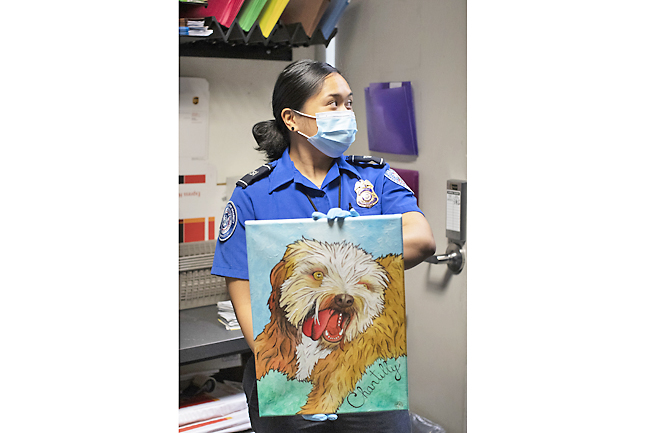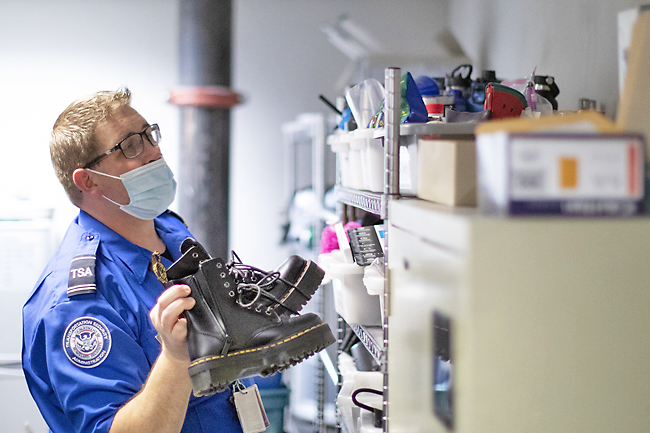Hannah Sampson
THE WASHINGTON POST – The giant white bunny has become a fixture in the windowless room at Dulles International Airport in Northern Virginia.
“That’s my favourite,” said Transportation Security Administration (TSA) officer Kat Claro.
“It’s been in the office for quite some time. I just can’t let it go.”
Inside the TSA lost-and-found office, the stuffed rabbit has plenty of company.
Someone’s long-limbed pink monkey toy is waiting to be claimed, along with a plush version of Jason from the Friday the 13th movies. There are coat-packed racks, cabinets stacked with laptops and tablets, and bins dedicated to car keys, prescription glasses, sunglasses, belts, jewellery and other trinkets. Carry-on bags line the floor. Straw hats nestle atop other straw hats on a shelf. And a stack of left-behind coronavirus vaccine cards – representing a month’s worth of forgetfulness – stands more than two inches high on a table.
Every morning, Claro and lead officer Wesley Hornberger visit the airport’s five security checkpoints to gather the bits and pieces that travellers forgot. These aren’t the banned items that aren’t allowed on planes, which go through their own processes. These are the baubles removed from pockets, the bags that stayed on the belt, and the computers that never made it out of the tray.
“People who have lost an item don’t typically know where to look to find it,” TSA spokeswoman Lisa Farbstein said. “Does the airport have it? Does the airline have it? Does TSA have it? Not too many people would even think that TSA would have it.”



In normal travel times, when nearly two million people flew per day, the TSA estimates 90,000 to 100,000 items were left at checkpoints every month across the country. Daily passenger numbers now typically fall between 1.2 and 1.6 million.
Some airports handle the goods as part of their own broader lost-and-found programmes.
Others – including Dulles, nearby Reagan National, Boston Logan, Newark Liberty and LaGuardia – have TSA personnel handle the collection, storing items and ultimately returning them or getting rid of them.
A TSA website provides phone numbers and links for online forms to claim lost property.
The forms ask for a date, time, airline, flight number and detailed description – down to a computer’s lock screen or background photo.
Hornberger and Claro said their job gets easier when travellers put any kind of personalisation on their electronics: A sticker, a case or – even better – a name. They will try to reach people whose luggage has a tag with contact information.
They inventory much of the property with dates, times and checkpoint location. Travellers who come in can search through glasses, for example, to see if their pair has showed up. If someone needs to identify a laptop without any distinguishing features, they might be asked to log in to prove ownership.
Some items just beg for attention. Upon the shelf of claimed-but-not-yet-fetched property were a fancy Stetson hat in a case, a bag full of beach toys and a painting of a fluffy little dog named Chantilly.
“Obviously this is an easy item to point out,” Claro said.
The agency promises to keep lost goods for a minimum of 30 days; at Dulles, the officers try to keep them for an extra month and will hang on to big-ticket items such as laptops for longer. TSA officers send unclaimed property from Dulles to the state to be sold, donated or destroyed, with proceeds going to state coffers. Electronics are first sent to a warehouse to have any identifying information be wiped.
Once an item is claimed, travellers have 90 days to pick it up, send a designee to get it, or – if it’s not too large – mail an envelope or box to the office to have it returned. Roughly 15 to 20 people come to the office every day, Hornberger said.
On a recent weekday, Ted Witmer saw how the recovery process worked when he came to the rescue of a friend who flew to Ethiopia and left a laptop behind.
“He was seated on the plane about to take off,” said Witmer, who lives about 12 minutes from the airport in Virginia. Witmer found the TSA form online and sent it to his friend to fill out when he landed in Addis Ababa.
“I didn’t know that this was one of their services,” he said.
The experience inspired Witmer to take action, too, following TSA recommendations to put his name and contact information on his phone and laptop.
The TSA officers said they have witnessed some happy reunions. Claro said she remembered a woman who was waiting outside the office when it opened, hoping to find her son’s lost laptop after he left on an international flight. It was there, and the relieved mum “started crying in the office”, Claro said.
She has also helped people find sentimental items, such as clothing that belonged to a deceased relative.
“Everything has a story,” she said.
Hornberger once helped rush identification to a man in time for him to board a cruise in Hawaii. That earned him a nice letter of thanks.
“We’re thanked a lot more in here than on the checkpoint,” he said.





